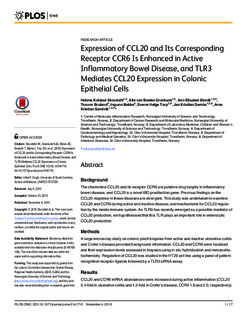| dc.contributor.author | Skovdahl, Helene Kolstad | |
| dc.contributor.author | Granlund, Atle Van Beelen | |
| dc.contributor.author | Østvik, Ann Elisabet | |
| dc.contributor.author | Bakke, Ingunn | |
| dc.contributor.author | Bruland, Torunn | |
| dc.contributor.author | Torp, Sverre Helge | |
| dc.contributor.author | Damås, Jan Kristian | |
| dc.contributor.author | Sandvik, Arne Kristian | |
| dc.date.accessioned | 2015-11-17T12:19:53Z | |
| dc.date.accessioned | 2015-11-18T11:39:13Z | |
| dc.date.available | 2015-11-17T12:19:53Z | |
| dc.date.available | 2015-11-18T11:39:13Z | |
| dc.date.issued | 2015 | |
| dc.identifier.citation | PLoS ONE 2015 | nb_NO |
| dc.identifier.issn | 1932-6203 | |
| dc.identifier.uri | http://hdl.handle.net/11250/2364468 | |
| dc.description.abstract | Background:
The chemokine CCL20 and its receptor CCR6 are putative drug targets in inflammatory bowel disease, and CCL20 is a novel IBD predilection gene. Previous findings on the CCL20 response in these diseases are divergent. This study was undertaken to examine CCL20 and CCR6 during active and inactive disease, and mechanisms for CCL20 regulation by the innate immune system. As TLR3 has recently emerged as a possible mediator of CCL20 production, we hypothesised that this TLR plays an important role in enterocytic CCL20 production.
Methods:
A large microarray study on colonic pinch biopsies from active and inactive ulcerative colitis and Crohn’s disease provided background information. CCL20 and CCR6 were localized and their expression levels assessed in biopsies using in situ hybridization and immunohistochemistry. Regulation of CCL20 was studied in the HT29 cell line using a panel of pattern recognition receptor ligands followed by a TLR3 siRNA assay.
Results:
CCL20 and CCR6 mRNA abundances were increased during active inflammation (CCL20 5.4-fold in ulcerative colitis and 4.2-fold in Crohn’s disease; CCR6 1.8 and 2.0, respectively). CCL20 and CCR6 mRNA positive immune cells in lamina propria were more numerous, and CCL20 immunoreactivity increased massively in the epithelial cells during active inflammation for both diseases. TLR3 stimulation potently induced upregulation and release of CCL20 from HT29 cells, and TLR3 silencing reduced CCL20 mRNA and protein levels.
Conclusions:
The CCL20-CCR6 axis is involved during active inflammation in both ulcerative colitis and Crohn’s disease. The epithelial cells seem particularly involved in the CCL20 response, and results from this study strongly suggest that the innate immune system is important for activation of the epithelium, especially through TLR3. | nb_NO |
| dc.language.iso | eng | nb_NO |
| dc.publisher | Public Library of Science | nb_NO |
| dc.title | Expression of CCL20 and Its Corresponding Receptor CCR6 Is Enhanced in Active Inflammatory Bowel Disease, and TLR3 Mediates CCL20 Expression in Colonic Epithelial Cells | nb_NO |
| dc.type | Journal article | nb_NO |
| dc.type | Peer reviewed | en_GB |
| dc.date.updated | 2015-11-17T12:19:53Z | |
| dc.source.journal | PLoS ONE | nb_NO |
| dc.identifier.doi | 10.1371/journal.pone.0141710 | |
| dc.identifier.cristin | 1287673 | |
| dc.description.localcode | © 2015 Skovdahl et al. This is an open access article distributed under the terms of the Creative Commons Attribution License, which permits unrestricted use, distribution, and reproduction in any medium, provided the original author and source are credited. | nb_NO |
